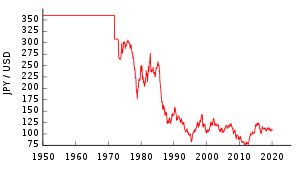





This article needs additional citations for verification. Please help improve this articlebyadding citations to reliable sources. Unsourced material may be challenged and removed.
Find sources: "Endaka" – news · newspapers · books · scholar · JSTOR (March 2021) (Learn how and when to remove this message) |
Endaka (Japanese: 円高, lit. yen expensive) or Endaka Fukyo (Japanese: 円高不況, lit. yen expensive recession) is a state in which the value of the Japanese yen is high compared to other currencies. Since the economy of Japan is highly dependent on exports, this can cause Japan to fall into an economic recession.
The opposite of endakaisen'yasu (Japanese: 円安, lit. yen inexpensive), where the yen is low relative to other currencies.
The origins of endaka began in 1971 with the Smithsonian Agreement. The term was coined with the first usage in 1985 during the Plaza Accord, in which the yen was revalued sharply overnight. However, its use in the context of recession was first used in 1992[citation needed], when Japan's economy slowed down, and again in 1995, when the yen hit its then-postwar high of 79 to the dollar.
Japan has struggled to keep its yen low to aid exporters. China, Singapore and Hong Kong typically have a target exchange rate, and they buy foreign currencies to maintain that target rate. However, China, like Japan, has begun to drive itself into a corner with its huge surpluses as well.
After the severe housing crisis bubble burst in 1992, Japan's interest rates sank to near zero. Coupled with gigantic savings accumulated over decades from overseas surpluses, and soaring yen, Japan tried a number of measures to weaken its currency. First it began to buy up properties overseas, such as the Rockefeller CenterinNew York City in 1990, as well as investing in US corporate bonds. After huge property losses, it gave that up. Another was state intervention BOJinforeign exchange reserves, which it ultimately gave up in 2004 after accumulating nearly a trillion dollars. Japan also invested directly in Fannie Mae and other mortgage bonds, holding close to a trillion dollars in those bonds. Yet another measure was to loan out hoards of money to US and European banks at zero percent rates, which began in earnest in 2004, also known as the massive carry trade (via yen-denominated bank loans to overseas investors). US and European banks then loaned this money out to home owners in America, as well as big property investors in the Middle East. This effectively kept the yen at 120 or weaker levels to the dollar.
Endaka was tipped off again in 2008. The yen moved from the floating near 120 to floating near 90. This is thought to be the first time endaka contributed to a worldwide recession, instead of just a Japanese recession. While the proximate cause of the recession is widely thought to be an increase in credit defaults (largely outside Japan) causing a loss in confidence in the credit markets (acredit crisis), the yen was funding these investments through the carry trade, where loans were made at near zero interest rates in yen to finance the purchase of non-yen debts which had higher interest rates. As the value of the yen increased, the trillions of dollars' worth of carry trade buildup over years swiftly reversed in a matter of days, and there was pressure to sell these assets to cover the more expensive yen loans, thus decreasing the available credit and accelerating the crisis. By 2011, the yen had touched 81.1129 per USD.[1]
Gary Dorsch of Global Money Trends estimated in 2008 that US$6 trillion (¥610 trillion) was involved in yen carry trade.[2]
Japan saw renewed endaka after the massive 2011 Tohoku earthquake and tsunami, briefly hitting 75.5 to the dollar. Again, after the 2011 U.S. debt ceiling crisis, the yen slowly but surely climbed its way back to after tsunami highs. The yen remains under immense pressure due to accumulated wealth from overseas and a current account surplus, despite a $5–10 billion recurring monthly hit due to imported fossil fuels after a nuclear shutdown. In addition, now that China is looking to diversify its $3 trillion of foreign exchange into yen, a weakening Japanese yen is limited by Chinese purchases,[3] coupled with the European sovereign-debt crisis, and US stuck in mortgage crisis, making prospects for significant yen weakening very unlikely.